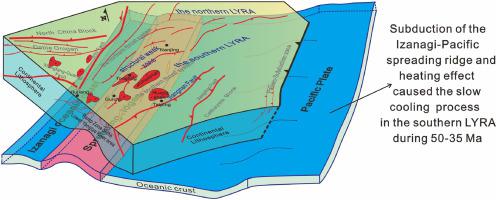Gondwana Research ( IF 7.2 ) Pub Date : 2021-03-02 , DOI: 10.1016/j.gr.2021.02.016 Pengcheng Wang , Yanhui Suo , Xianzhi Cao , Junjiang Zhu , Bo Liu , Guangzeng Wang , Jie Zhou , Xiyao Li , Sanzhong Li , Gege Hui

|
Late Cretaceous-Cenozoic large-scale extension in the eastern South China Block (SCB) has been widely studied. While the exact timing is not well constrained and the geodynamics is inconclusive. Here, we studied the cooling and uplifting history of the southern Lower Yangtze River area (LYRA) in the northeastern SCB using the fission track chronology. The apatite fission track (AFT) single grain ages are decomposed into two best-fit age peaks during 80–50.2 Ma and 43.7–34.5 Ma, respectively. The thermal history modeling of apatite reveals that there exists a rapid cooling process during ca. 80–50 Ma, a slow cooling process during ca. 50–35 Ma and another rapid cooling process during ca. 35–12 Ma. The 80–50.2 Ma age peak corresponds to the rapid cooling process during ca. 80–50 Ma, and the 43.7–34.5 Ma age peaks roughly correspond to the slow cooling process during ca. 50–35 Ma. The tectonic analysis shows that the rapid cooling stage during ca. 80–50 Ma, linked to the rapid rifting in the southern LYRA and coeval strong rifting in the northern LYRA, has resulted from flat subduction of young oceanic crust of the Izanagi Plate. The slow cooling stage during ca. 50–35 Ma is linked to the subduction of the Izanagi-Pacific spreading ridge. The another rapid cooling stage during ca. 35–12 Ma corresponds to a rapid uplifting of the southern LYRA, resulted from the regional compression and tectonic inversion in East China.
中文翻译:

长江下游南部地区晚白垩世-新生代冷却:对Izanagi和太平洋板块俯冲的响应
华南地块东部(SCB)晚白垩世-新生代的大范围扩张已被广泛研究。虽然确切的时间安排没有得到很好的限制,并且地球动力学还没有定论。在这里,我们使用裂变径迹年代学研究了东南SCB长江下游南部地区(LYRA)的降温和隆升历史。磷灰石裂变径迹(AFT)的单粒年龄分别分解为80-50.2 Ma和43.7-34.5 Ma的两个最佳年龄峰。磷灰石的热历史模型表明,在约200℃期间存在快速冷却过程。80–50 Ma,大约在一个缓慢的冷却过程中。大约50-35 Ma,在此期间另一个快速冷却过程。35-12 Ma。80-50.2 Ma的年龄峰值对应于大约在1989年期间的快速冷却过程。80-50 Ma,和43.7-34。5 Ma的年龄峰值大致对应于大约1200摄氏度的缓慢冷却过程。50–35 Ma。构造分析表明,该过程中的快速冷却阶段。80-50 Ma,与LYRA南部的快速裂谷和LYRA北部的同期强裂谷有关,是由于Izanagi板块年轻洋壳的平展俯冲造成的。大约在缓慢的冷却阶段。50-35 Ma与伊萨纳吉-太平洋扩张脊的俯冲有关。大约在另一个快速冷却阶段。35-12 Ma对应于LYRA南部的快速隆升,这是由于华东地区的区域压缩和构造反转所致。这是由于Izanagi板块的年轻洋壳平展俯冲造成的。大约在缓慢的冷却阶段。50-35 Ma与伊萨纳吉-太平洋扩张脊的俯冲有关。大约在另一个快速冷却阶段。35-12 Ma对应于LYRA南部的快速抬升,这是由于华东地区的区域压缩和构造反转所致。这是由于Izanagi板块的年轻洋壳平展俯冲造成的。大约在缓慢的冷却阶段。50-35 Ma与伊萨纳吉-太平洋扩张脊的俯冲有关。大约在另一个快速冷却阶段。35-12 Ma对应于LYRA南部的快速抬升,这是由于华东地区的区域压缩和构造反转所致。











































 京公网安备 11010802027423号
京公网安备 11010802027423号